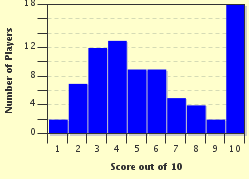Quiz Answer Key and Fun Facts
1. Without a doubt the Imperial Japanese Navy (IJN) carrier based fighter popularly known as the A6M "Zero" (Rei-sen) was the most famous aircraft produced by Japan. What was the official Allied code name for the A6M?
2. During a brief stint into the Indian Ocean in search of the British Far Eastern Fleet Japan's 1st Air Fleet and the Malay Force sank many ships. Of the following Japanese aircraft, which type is credited with the sinking of the British aircraft carrier HMS Hermes and Australian destroyer HMAS Vampire on 9 April 1942, and British heavy cruisers HMS Cornwall and HMS Dorsetshire on 5 April 1942?
3. For the raid on Pearl Harbor Japans carrier strike force (Kito Butai) used three types of aircraft; fighters, torpedo bombers, and dive bombers. Of the torpedo bombers about how many actually carried torpedoes?
4. While on their way back to Singapore after an unsuccessful attempt to intercept Japanese landings on the coast of Malaysa Royal Navy battleship HMS Prince of Wales and battlecruiser HMS Repulse were sunk on 10 December 1941 by what type of Japanese aircraft?
5. By the closing months of the war Imperial Japan found itself unable to stop the Allies by conventional means. Japanese war leaders then resorted to forming kamikaze (Navy version) units (the Army version were called Tokkatai) for suicide missions, in the hope of inflicting such damage to Allied vessels the government would resort to a negotiated peace. Of the Japanese aircraft, which one was specifically designed from scratch for suicide missions?
6. The predecessor to the famed 'Zero', this little fighter aircraft was the world's first all metal monoplane carrier fighter. It first saw action in the Sino-Japanese War and was a nimble and sturdy airframe. Which fighter was this?
7. The Mitsubichi Ki-21 Army type 97 twin engined bomber served the Imperial Japanese Army well when first introduced with the 60th and 61st Sentai in 1938. When the war expanded to SE Asia and the Dutch East Indies from December 1941 through the early months of 1942 it was the main IJA bomber. By 1943 the bomber had become obsolete for first line duty and was relegated to secondary roles. This plane eventually ended up serving the Emperor in what major role?
8. Floatplanes were an indispensable part of the IJN inventory. These planes served mainly as reconnaissance aircraft from floatplane bases,h as in Tulagi in the Solomons, and on board cruisers, battleships and support ships . The ship borne floatplanes were launched from catapults attached to the mother vessel and recovered by means of a winch. Floatplanes served in all areas of the Pacific and Indian ocean. Which floatplane was used to reconnoiter Pearl Harbor before the attack and was also used in the battle of Midway to look for the American aircraft carriers?
9. Like all belligerents in WWII, Japan also used foreign built aircraft for front line service. One of these was an Italian twin engined bomber which served in China with the 12th and 20th Sentai. When the Japanese engaged the Soviets at Khalkhin Gol the 12th Sentai was redeployed to the Mongolian border and there it remained until it was slowly phased out of frontline service, being replaced by the Mitsubichi Ki-21 "Sally". Which Italian twin engined bomber was this?
10. During WWII Japanese manned aircraft bombed several US territories outside the continental United States: Pearl Harbor, Guam, the Philippines, Alaska, Wake Island and so forth, but only one aircraft was able to bomb mainland United States. Which aircraft was this?
Source: Author
Joe_Meek
This quiz was reviewed by FunTrivia editor
bloomsby before going online.
Any errors found in FunTrivia content are routinely corrected through our feedback system.

